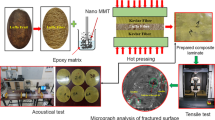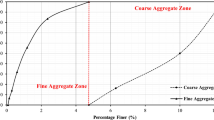Abstract
The rise in demand and interest in Arctic exploration has brought new challenges with regard to the mechanical behavior of lightweight offshore structures with fiber-reinforced composite materials. These materials experience drastic changes and degradation in their macro-and microstructures when exposed to seawater and cold temperatures during service. Therefore, it is critical to have a detailed comprehension of the mechanical behavior and failure mechanisms of these materials in Arctic conditions. Within the scope of the current study, low-velocity repeated impact behavior of carbon fiber/vinyl ester composites in Arctic temperature (\(-50\ ^{\circ }\hbox {C}\)) is investigated. Impact responses, such as the contact force, displacement and absorbed energy, at four impact energies of 20, 25, 30 and 35 J under repeated impact loading until perforation are determined at \(-50\ ^{\circ }\hbox {C}\) and compared against those at room temperature (\(25\ ^{\circ }\hbox {C}\)). The number of impacts required for perforation, the rate of reduction in impact force, the degree of damage and the failure mechanisms change significantly with varying impact energies and in situ ambient temperatures, and they are elucidated in detail in this paper.












Similar content being viewed by others
References
A. D3039M-17 (2017) Standard test method for tensile properties of polymer matrix composite materials. J ASTM Int D3039M 17:1–13
A. D695-15 (2015) Standard test method for compressive properties of rigid plastics. J ASTM Int D695 15:1–8
A. International (2015) ASTM D7136/D7136M-15. Standard test method for measuring the damage resistance of a fiber–reinforced polymer matrix composite to a drop-weight impact event. J ASTM Int D7136/D7136M-15:1–16
Abrate S (1994) Impact on laminated composites: recent advances. Appl Mech Rev 47(11):517
Babu S, Shivanand HK (2014) Impact analysis of laminated composite on glass fiber and carbon fiber. Int J Emerg Technol Adv Eng 4(6):824
Bienia J, Surowska B, Jakubczak P (2015) Influence of repeated impact on damage growth in fibre reinforced polymer composites. Maint Reliab 17:194
Cantwell W, Morton J (1990) Impact perforation of carbon–fiber reinforced plastics. Compos Sci Technol 38:119
Caprino V, Lopresto V, Scarponi C, Briotti G (1999) Effect of ZnO nanowire morphology on the interfacial strength of nanowire coated carbon fibers. Compos Sci Technol 59:2279
Chalmers DW (1994) The potential for the use of composite materials in marine structures. Mar Struct 7:441
Chittajallu K (2004) Computational modeling of the vacuum assisted resin transfer molding (VARTM) process. Thesis. Clemson University, Clemson
Chu XX, Wu ZW, Huang RJ, Zhou Y, Li LF (2010) Mechanical and thermal expansion properties of glass fibers reinforced peek composites at cryogenic temperatures. Cryogenics 50:84
Dempsey JP (2000) Research trends in ice mechanics. Int J Solids Struct 37:131
Dutta PK (1994) Low-temperature compressive strength of glass–fiber–reinforced polymer composites. J Offshore Mech Arct Eng 116:167
Garcia R, Castellanos AG, Prabhakar P (2017) Influence of arctic seawater exposure on the flexural behavior of woven carbon/vinyl ester composites. J Sandw Struct Mater. https://doi.org/10.1177/1099636217710821
Gibson AG (2003) The cost effective use of fibre reinforced composites offshore. In: Report for the health and safety executive 2003
Gibson AG (2014) A review on composite materials for offshore structures. In: Materials technology, vol 5. ASME, California
Gomez-del Rio T, Zaera R, Barbero E, Navarro C (2006) Damage in cfrps due to low velocity impact at low temperature. Composites: Part B 36:41
Greene E (1990) Use of fiber reinforced plastics in the marine industry. In: Home-transport research international documentation, SSC-360
Guedes Soares C, Garbatov Y (2017) Progress in the analysis and design of marine structures. In: Proceedings of the 6th international conference on marine structures (MARSTRUCT 2017). CRC Press, Balkema
Hartwig G, Knaak S (1984) Fibre-epoxy composites at low temperatures. Cryogenics 24(11):639–647
Ibekwe SI, Mensah PF, Li G, Pang SS, Stubblefield MA (2007) Impact and post impact response of laminated beam beams at low temperatures. Compos Struct 79:12
Icten BM (2015) Low temperature effect on single and repeated impact behavior of woven glass–epoxy composite plates. J Compos Mater 49:1171
Im K, Cha C, Kim S, Yang I (2001) Effects of temperature on impact damages in cfrp composite laminates. Composites: Part B 32:669
Jones N (1993) Recent studies on the response of structures subjected to large impact loads. In: The Society of Naval Architects and Marine Engineers and the Ship Structure Committee, pp 1–22
Julias A, Murali V (2014) Effect of carbon fiber position on the impact behavior og glass/carbon fiber hybrid composite laminates. Int J Appl Eng Res 9(26):9103
Kim M, Kang S, Kim C, Kong C (2007) Tensile response of graphite/epoxy composites at low temperatures. Compos Struct 79:84
Li XK, Liu PF (2017) Expperimental analysis of low-velocity impact beaviors of carbon fibre composite laminates. J Fail Anal Prev 17:1126
Lopez-Puente J, Zaera R, Navarro C (2002) The effect of low tempertures on the intermediate and high velocity impact response of cfrps. Composites: Part B 33:559
Morais SN, Monteiro WA, d’Almeida JR (2009) Evaluation of repeated low energy impact damage in carbon–epoxy composite materials. Compos Struct 91:318
Murat BIS, Rahman AAA (2017) Study of impact damage beahvior in coven carbon fiber plates. Eng Phys Int Conf EPIC 2016:47–54
Naik NK, Chandreshakarkhar Y, Mduri S (2000) Polymer matrix woven fabric composites subjected to low velocity impact: Part I. Damage initiation studies. J Reinf Plast Compos 19:912
Nguyen S, James T, L I (2016) Low, medium and high velocity impact on composites. In: 16th international conference on composite structures, pp 1–2
Rajkumar GR, Krishna M, Narasimha HN, Sharma SC, Vishnu KR (2012) Experimental ivestigation of low-velocity repeated impacts on glass fiber metal composites. J Mater Eng Perform 21:1485
Safri S, Sultan M, Yidris N, Mustapha F (2014) Low velocity and high velocity impact test on composite materials—a review. Int J Eng Sci 3(9):50
Salehi-Khojin A, Bashirzadeh R, Mahinfalah M, Nakhaei-Jazar R (2006) The role of temperature on impact properties of kevlar/fiberglass composite laminates. Composites: Part B 37:593
Sayer M, Bektas NB, Sayman O (2010) An experimental investigation on the impact behavior of hybrid composite plates. Compos Struct 92:1256
Selvaraju S, Illaiyavel S (2011) Application of composites in marine industry. J Eng Res Stud 2:89
Shyr TW, Pan YH (2003) Impact resistance and damage characteristic of composite laminates. Compos Struct 62:193
Signor AW, Chin JW (2003) Effects of ultraviolet radiation exposure on vinyl ester matrix resins: chemical and mechanical characterization. Polym Degrad Stab 79:1
Sjoblom PO, Hartness JT, Cordell TM (1988) On low-velocity impact testing of composite materials. Compos Mater 22:30
Sobrinho LL, Ferreira M, Bastian FL (2009) The effect of water absorption on an ester vinyl resin system. Mater Res 12:353
Sultan MT, Worden K, Staszewski WJ, Hodzic A (2012) Impact damage characterization of composite laminates using a statistical approach. Compos Sci Technol 72:1108
Szekrenyes A (2011) Overview on the experimental investigations of the fracture toughness in composite materials. J Eng Mater Technol 100:1
Wang XF, Zhao JH (2001) Monte-Carlo simulation to the tensile mechanical behaviors of unidirectional composites at low temperature. Cryogenics 41(9):683–691
Yusriah L, Mariatti M, Bakar AA (2010) The properties of vinyl ester composites reinforced with different types of woven fabric and hollow phenolic micospheres. J Reinf Plast Compos 29(20):3066
Zhu L, Faulkner D (1996) Damage estimate for plating ships and platforms under repeated impacts. Mar Struct 9:697
Acknowledgements
The authors would like to acknowledge the support through the AFOSR Young Investigator Award (FA9550-15-1-0216) and DoD HBCU/MI Basic Research Grant (W911NF-15-1-0430) for conducting the research presented in this paper.
Author information
Authors and Affiliations
Corresponding author
Ethics declarations
Conflict of interest
On behalf of all authors, the corresponding author states that there is no conflict of interest.
Additional information
Publisher's Note
Springer Nature remains neutral with regard to jurisdictional claims in published maps and institutional affiliations.
Rights and permissions
About this article
Cite this article
Castellanos, A.G., Prabhakar, P. Durability and failure mechanics of woven carbon composites under repeated impact loading in Arctic conditions. Multiscale and Multidiscip. Model. Exp. and Des. 1, 157–170 (2018). https://doi.org/10.1007/s41939-018-0024-x
Received:
Accepted:
Published:
Issue Date:
DOI: https://doi.org/10.1007/s41939-018-0024-x




